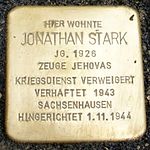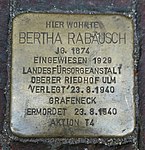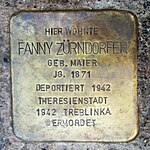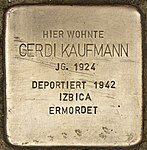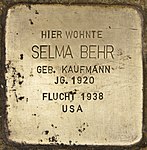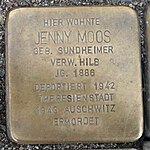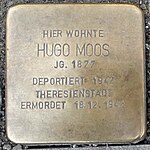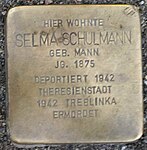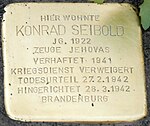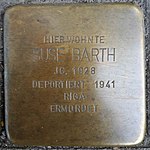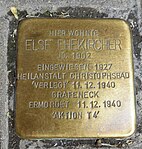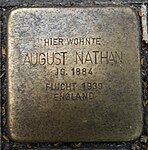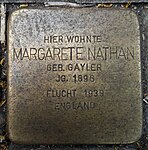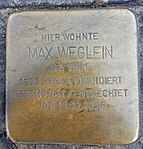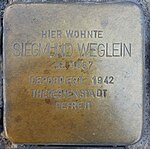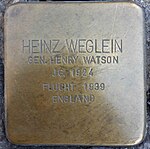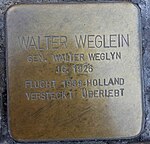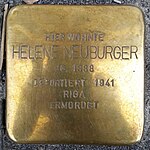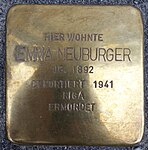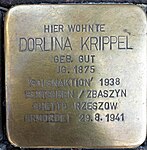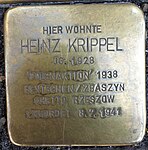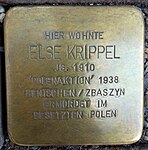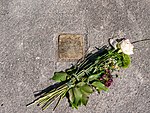List of stumbling blocks in Ulm
In the list of stumbling blocks in Ulm , the stumbling blocks that have existed in Ulm so far are listed. They are part of the Europe-wide project “Stolpersteine” by the artist Gunter Demnig . These are decentralized memorials , which are supposed to remind of the fate of those people who lived in Ulm and were deported by the National Socialists and, among other things, murdered in concentration camps and extermination camps or forced to flee their homeland.
Many of Ulm's Stolpersteine are dedicated to former Jewish citizens, other sick and disabled people, deserted soldiers, Jehovah's Witnesses and foreign forced laborers.
The first 14 stumbling blocks were laid in Ulm in May 2015. The preparatory work for the laying was done by the Ulmer Stolpersteine initiative founded in 2014 , which is entirely supported by civic engagement. More than 30 active volunteers are involved in the initiative. The campaign is financed by donations and receives support from the Ulm Remembrance Foundation , among others .
The list contains the address of the respective stumbling block, the name of the Nazi victim, some biographical information and - if available - a picture of the stumbling block. Detailed descriptions of the individual fates are linked to the respective persons and can be called up by clicking on the word "Biography".
Overview
| address | Surname | Life | image |
|---|---|---|---|
| Olgastrasse 85 |
Dr. Ludwig Hecht |
Dr. Ludwig Hecht (born October 14, 1866) was a general practitioner and poor doctor until the National Socialists withdrew his license to practice medicine. Via the ghetto building on Ensingerstr. 3 and the Jewish old people's home in Oberstotzingen Castle he was transferred to the Theresienstadt concentration camp on August 22, 1942 , where he died of malnutrition on January 21, 1943. -> biography |
|
| Olgastrasse 85 |
Rosa Hecht (née Thalmessinger) |
Rosa Hecht (born August 15, 1870 in Neu-Ulm) was the wife of Ludwig Hecht . She and her husband were deported to Theresienstadt via the ghetto house and the Jewish retirement home and died there on January 13, 1943 of malnutrition. -> biography |
|
| Olgastrasse 114 |
Jakob Frenkel |
Jakob Frenkel (* 1881) was a tobacco and cigar dealer with several shops, first in Stuttgart then in Ulm. On October 28, 1938, he was deported to Zduńska Wola as part of the Poland campaign and was later murdered in occupied Poland under circumstances that were not clear . -> biography |
|
| Olgastrasse 114 |
Ida Frenkel (nee Chaskelowitz) |
Ida Frenkel (* 1879) was Jakob Frenkel's wife . She was also expelled from the Poland campaign and later murdered. -> biography |
|
| Olgastrasse 114 |
Adolf Frenkel |
Adolf (originally Abraham) Frenkel (born January 28, 1904) was the son of Jakob and Ida Frenkel . He trained in business and worked in his parents' shops. Around 1933 he tried to emigrate to America , but it did not succeed. He was also deported in the Poland campaign . He was able to return to Germany during the war. On December 1, 1941, he was deported to Riga and murdered in 1942 in the Salaspils labor education camp . -> biography |
|
| Olgastrasse 114 |
Martha Frenkel (née Einstein, adopted name Frankel) |
Martha Frenkel (born February 4, 1906) was the wife of Adolf Frenkel . After being deported to Poland, she was able to come back with her husband and son Heinz Frenkel because she was born in Germany. She was able to flee to the USA in September 1941 and built a new life there. Martha Frenkel married again and died as Martha Bamberger on March 31, 1995 in New York . -> biography |
|
| Olgastrasse 114 |
Heinz Frenkel (adopted name Frankel) |
Heinz Joachim Frenkel (born June 20, 1933 in Ulm) is the son of Adolf and Martha Frenkel . After he and his parents returned to Germany from Poland , they managed to place him on a German Jewish Children's Aid children's transport in 1940 . He was one of around 1,000 children who came to the United States this way . Today he lives under the name Henry Frankel in the USA (as of 2015). -> biography |
|
| Friedrich-Ebert-Strasse 14 |
Dr. Paul Moss |
The doctor Paul Heinrich Moos (born September 10, 1902 in Ulm) specialized in nervous diseases. In 1934 he traveled to the USA with the support of his cousin Albert Einstein . Bitter irony: the neurologist Paul Moos fell ill with schizophrenia and therefore had to leave the USA for Germany in 1938. On September 29, 1938, he was forcibly sterilized in Riedlingen. On May 9, 1940, he was taken from the Zwiefalten sanatorium to the Grafeneck extermination facility and gassed on the same day. -> biography |
|
| Friedrich-Ebert-Strasse 14 |
Rudolf Moos |
Franz Rudolf Moos (born July 30, 1910 in Ulm) was a trainee lawyer. After the Reichspogromnacht he was sent to the Dachau concentration camp . Since he already had a visa, he could leave the country immediately after a few weeks, on condition that he should leave. He fled to Brazil in late 1938 . -> biography |
|
| Friedrich-Ebert-Strasse 14 |
Selma Moos (nee Gutmann) |
Selma Moos (born December 3, 1877) was the mother of Paul and Rudolf Moos . She was deported to Gurs in what was then Vichy France on October 22, 1940 . On August 6, 1942, she was supposed to be taken to Auschwitz , but died in the Drancy transit camp . -> biography |
|
| Marketplace 14 |
Lina Einstein |
Lina Einstein (born November 16, 1875 in Ulm) was a cousin of Albert Einstein , who also tried to get her an exit permit to the USA. This did not work. In 1940 she was admitted to the Jewish retirement home in Oberstotzingen until, like many older Jews, she had to conclude a home purchase contract for the “ retirement ghetto” Theresienstadt . She was brought from Theresienstadt to Treblinka and murdered there. -> biography |
|
| Herdbruckerstraße 6 |
Jonathan Stark |
Jonathan Stark (born July 8, 1926 in Ulm) was a Jehovah's Witness . For this reason, he refused the Reich Labor Service : "I will not carry a broken cross on my arm". It was the end of 1943 by the Gestapo in protective custody taken in February 1944 in the youth concentration camp Moringen deported. On November 1, 1944, the eighteen-year-old was executed in Sachsenhausen concentration camp without trial. |
|
| Herdbruckerstraße 8 |
Ludwig Levy |
Ludwig Levy (* 1870), born in Illingen in Saarland , has been running a large hat shop with his wife Sofie at Herdbruckerstraße 8 since 1899. From 1935 they had to lease the business and three years later they had to sell their house. Together with his wife, Ludwig Levy was first taken to the forced retirement home for Jewish seniors in Oberstotzingen Castle in 1942 , then deported to the Treblinka extermination camp via the Theresienstadt concentration camp . He died there on September 26, 1942. -> biography |
|
| Herdbruckerstraße 8 |
Sofie Levy (nee Gutmann) |
Sofie Levy (* 1872) was born in Philippsburg . She and her husband Ludwig Levy had been running a large hat shop at Herdbruckerstraße 8 since 1899. From 1935 they had to lease the business and sell their house three years later. Together with her husband, Sofie Levy was first taken to the compulsory retirement home for Jewish seniors in Oberstotzingen Castle in 1942 , then deported to the Treblinka extermination camp via the Theresienstadt concentration camp . She died there on September 26, 1942. -> biography |
|
| Küfergasse 1 |
Bertha Rabausch |
Bertha Rabausch (* 1874) was admitted to the state welfare institute Oberer Riedhof in 1929 . On August 23, 1940, she was deported to the Grafeneck killing center as part of Operation T4 and murdered in the gas chamber there on the same day . -> biography |
|
| New Street 32 |
Mathilde Fischer |
The physically and mentally little resilient Mathilde Fischer (born December 18, 1904) was admitted to the Gottlieb-Weißer-Haus in Schwäbisch Hall in 1937 due to illness . From there she came to the Christophsbad Clinic in Göppingen in 1940 . Without her parents' knowledge, she was moved to the Klinikum am Weissenhof in Weinsberg in March 1941 . On April 22, 1941, she was deported to the Hadamar killing center in the course of Operation T4 and murdered in the gas chamber there on the same day . -> biography |
|
| Susoweg 17 |
Fanny Zürndorfer (née Maier) |
Fanny Zürndorfer (born May 5, 1871) had only moved to Ulm in 1930 and had so few contacts. In the course of the " Aryanization ", her daughter Ruth Hilble had to sell the house at Susoweg 17 in 1939. Fanny Zürndorfer used half the money to buy into the Herrlingen forced retirement home . When this was dissolved, she was forcibly relocated to the Jewish senior citizens' home at Schloss Oberstotzingen . On August 22, 1942, she came over the transit camp Killesberg in the Theresienstadt concentration camp . On September 29, 1942, Fanny Zürndorfer was deported to Treblinka , where she was murdered immediately upon arrival. -> biography |
|
| Susoweg 17 |
Ruth Waldmann (née Zürndorfer, widowed Hilble) |
Ruth Waldmann (born March 19, 1905) was the daughter of Fanny Zürndorfer . In 1930 she married the "non-Jew" Fritz Hilble , whose fur business was therefore boycotted after the seizure of power . Her husband Fritz died in February 1937. In August 1939 Ruth Hilble married Maximilian Waldmann , with whom she wanted to emigrate to America. This was rejected by the responsible American consul because Maximilian Waldmann had fought for Germany in the First World War . In 1940 son Jona was born , the family was forcibly quartered in an apartment with 2 other Jewish families. At the end of 1942 the family was transferred to the Darmstadt camp and in 1943 to the Theresienstadt concentration camp . The family survived the concentration camp because Ruth Waldmann's work in the kitchen saved them from starvation. Son Jona, however, died in 1980 from the long-term effects of the damage to his health there. -> biography |
|
| Frauenstrasse 134 |
Reinhold Bürkle |
Reinhold Bürkle (born March 22, 1915) was imprisoned in what was then the military detention center at Frauenstrasse 134 because he had deserted from the Wehrmacht . His death sentence was carried out on February 18, 1942 in Ulm at the shooting range in the Lehrer Valley. -> biography |
|
| Frauenstrasse 134 |
Jakob Eckstein |
Jakob Eckstein (born August 25, 1920) was imprisoned in what was then the military detention center at Frauenstrasse 134 because he had deserted from the Wehrmacht. His arrest came about only through the careless actions of his fiancée. The death sentence of the 24-year-old was carried out on March 17, 1945 in Ulm at the shooting range in the Lehrer Tal, one month after the birth of his daughter Ursula. -> biography |
|
| Frauenstrasse 134 |
Kurt Henne |
Kurt Henne (born December 18, 1914) was imprisoned in what was then the military detention center at Frauenstrasse 134 because he had deserted from the Wehrmacht. His death sentence was carried out on March 17, 1945 in Ulm at the shooting range in the Lehrer Valley. -> biography |
|
| Frauenstrasse 134 |
Karl Westerich |
Karl Westerich, born in Düsseldorf (born October 18, 1914), was imprisoned in what was then the military detention center at Frauenstrasse 134 because he had deserted from the Wehrmacht. His death sentence was carried out on December 14, 1944 in Ulm at the shooting range in the Lehrer Valley. Karl Westerich was 30 years old. -> biography |
|
| Frauenstrasse 134 |
Curt Erich Riesterer |
Curt Erich Riesterer (born June 30, 1917), who was born in Mannheim , was imprisoned in what was then the military detention center at Frauenstrasse 134 because he had deserted from the Wehrmacht. The 25-year-old's death sentence was carried out on March 22, 1943 in Ulm at the shooting range in the Lehrer Valley. -> biography |
|
| Frauenstrasse 134 |
Richard Stemmle |
Richard Stemmle (born September 19, 1922) was born in Seelbach. He was imprisoned in what was then the military detention center at Frauenstrasse 134 because he had deserted from the Wehrmacht . The death sentence of the 22-year-old was carried out on March 21, 1945 in Ulm at the shooting range in the Lehrer Valley. -> biography |
|
| Keplerstrasse 21 |
Rosa Kaufmann (née Smus) |
Rosa Kaufmann was born in Minsk in 1899 as Rosa Smus.
From 1910 the family lived in Munich , where in 1919 Rosa Smus married Hertz David Kaufmann. Her husband worked, among other things, as an employee at the Ulm tobacco and cigarette factory Monestra . The family settled in Ulm and had 3 children. Three years after the birth of the youngest daughter, husband Hermann (German name) died suddenly in 1927 at the age of 41. After that, for financial and health reasons, Rosa was no longer able to look after the children permanently, which is why she took them to the Israelite orphanage in Esslingen . Due to various psychological problems, Rosa Kaufmann was admitted to the Schussenried Sanatorium in 1931 . Despite the best efforts of those around her, her condition visibly deteriorated there. In 1932 Rosa Kaufmann was relocated to the Gottlieb-Weißer-Haus in Schwäbisch Hall . When this fell into the hands of the Nazis, it was in November 1940 as part of the Action T4 Euthanasia program in the intermediate institution Weinberg moved, "unhealed dismissed," there on 4 December 1940, another patient in the grafeneck taken and murdered. -> biography |
|
| Keplerstrasse 21 |
Gerdi Kaufmann |
Gerdi Kaufmann, the youngest daughter of Rosa Kaufmann , was born on September 23, 1924. She spent most of her childhood in the Israelite orphanage in Esslingen . The day after the Reichspogromnacht , the orphanage was stormed by SA men. The children and carers were forbidden to enter the house, children wandered around in the street and had to be looked after by friends and relatives.
Gerdi Kaufmann worked from 1940 as an intern in an old people's home and from February 23, 1942 in the Jewish forced retirement home in Dellmensingen . On April 24, 1942, the care staff was "evacuated" to an unknown destination. After the war it was possible to reconstruct that she was deported from Stuttgart to Izbica , a stopover for extermination camps in Eastern Europe, on April 26, 1942 . Her future fate is uncertain. -> biography |
|
| Keplerstrasse 21 |
Selma Behr (born Kaufmann) |
Selma Kaufmann (born August 27, 1920) was the daughter of Rosa Kaufmann and the oldest sister of Gerdi Kaufmann . Since there were disputes between Poland and Germany about the citizenship of Jews who had been living in Germany for a long time, she was considered stateless from 1938. On September 30, 1938, she managed to escape to the USA . She was guaranteed by Siegfried Behr , into whose family she later married. -> biography |
|
| Neue Strasse 95/97 |
Rabbi Dr. Julius Cohn |
Dr. Julius Cohn (born December 5, 1878) was rabbi for the Principality of Birkenfeld, in Karlsruhe and in Cannstatt before he became district rabbi in Ulm in 1928. He was close to the Association for Liberal Judaism and campaigned for the assimilation of Jews in Germany. During the Reichspogromnacht he was so badly mistreated on the Weinhof in front of the burning synagogue in Ulm that he could not be deported to Dachau the next day like the other Jewish men . -> biography |
|
| Neue Strasse 95/97 |
Dorothea Meth-Cohn |
Dorothea Meth (* 1904) first took care of Julius Cohn's first wife Herta until her death and later Julius Cohn himself after he was badly mistreated during the Night of the Reichspogroms . In 1939 she married Julius Cohn, as only rabbis and their families were allowed to leave Germany. After the outbreak of war, this hope was dashed for them.
In 1940 she took over the management of a Jewish retirement home, from where she was deported to Theresienstadt together with the residents in 1942.On October 19, 1944, she was brought to Auschwitz concentration camp and murdered. -> biography |
|
| Neue Strasse 95/97 |
Ernst-Otto Meth-Cohn |
Ernst-Otto Meth (* 1935) was adopted by his stepfather Julius Cohn in early 1939 after his mother Dorothea Meth was married , as only rabbis and their families were allowed to emigrate from Germany. In June 1939 he came to Edinburgh / Scotland on a Kindertransport .-> biography |
|
| Frauenstrasse 28 |
Karl Hermann Rueff |
Karl Rueff (born February 1, 1892) made it from war volunteer to reserve lieutenant in World War I , where he was wounded several times. After being wounded in the 1918 spring offensive , he was diagnosed with a mental illness that is now known as post-traumatic stress disorder . He did not recover from this illness and was therefore admitted to the Schussenried State Psychiatric Hospital in 1924 .
On June 18, 1940, he was transferred to the Grafeneck killing center and gassed on the same day . -> biography |
|
| Säntisstrasse 36 |
Ernst Dauner |
Ernst Dauner, born on September 4, 1913 in Ulm, grew up in Ulm and studied at the School of Civil Engineering in Stuttgart .
As a careerist, he became a member of the NSDAP on May 1, 1933 , without ever having held a position within the party. Dauner was married twice and he had three children. As a civil engineer at the "Süddeutsche Abwasser-Reinigungsgesellschaft mbH, Ulm adD", he was sent to the extermination camp for the task of renovating and planning the sewerage and sewage treatment plants in the city and the Auschwitz camp. Thousands of corpses were burned there every day. Dauner, very disturbed by what he had seen, talked about it in his company and surroundings, so he broke the absolute requirement of silence. - He was betrayed, arrested, sent to a psychiatric hospital and murdered on January 25, 1945 in the Dachau concentration camp . -> biography |
|
| Zinglerstrasse 44 |
Dr. Sigmar Ury |
Dr. Sigmar Ury (* 1880) reported to the front as a medical officer at the beginning of the First World War . After the war he reopened a practice in Ulm . How many liberal Jews he hoped after the seizure of power of the Nazis , times that for the better again, although early for a boycott was called to his practice. On 30 September 1938 he was in the wake of racial laws , the approval withdrawn. Shortly afterwards he had to move to a Jewish house .
He died on May 10, 1941 because he was refused medication for his kidney disease. -> biography |
|
| Zinglerstrasse 44 |
Hedwig Ury (nee Ullmann) |
Hedwig Ury (born February 26, 1894 in Ulm) was the wife of Dr. Sigmar Ury . She worked in his practice as a receptionist and assisted with treatments. She was still able to bring her son Peter to England, but after the death of her husband she was alone in Ulm. All of her friends and relatives had fled. She worked in the Herrlingen forced retirement home and later in the Jewish retirement home in Dellmensingen . In August 1942 she was deported to Theresienstadt via Stuttgart . In the 2 years there she probably worked as a nurse.
In October 1944 she was shipped to Auschwitz and immediately selected for killing. She was one of the last to die in Auschwitz. -> biography |
|
| Neutorstrasse 16 |
Jenny Moos (née Sundheimer, widowed Hilb) |
Jenny Moos was born in Nuremberg in 1886.
In 1913 she married the businessman Julius Hilb , with whom she had two sons: Kurt and Otto . Her husband was a highly decorated soldier who died in 1929. In the course of the "Aryanization", it lost its business. Her son Otto was badly mistreated during the Night of the Reichspogrom , but was able to escape to Israel with his brother. Jenny Moos was sent to several forced retirement homes before she was deported to Auschwitz on January 30, 1943 and murdered there. -> biography |
|
| Neutorstrasse 16 |
Kurt Hilb |
Kurt Hilb (* 1914) was the older son of Jenny Moos from her first marriage to Julius Hilb .
He was able to flee to Israel via England . -> biography |
|
| Neutorstrasse 16 |
Otto Hilb |
Otto Hilb (* 1915) was the second son of Jenny Moos from her marriage to Julius Hilb . He was mistreated during the Reichspogromnacht and then deported to the Dachau concentration camp .
With the help of forged papers he managed to escape via England to Israel . -> biography |
|
| Neutorstrasse 16 |
Hugo Moss |
Hugo Moos, born in Ulm in 1877, was the son of a businessman and an aunt of Albert Einstein .
In World War I Hugo Moss served as a soldier and became involved after his return in the German Democratic Party and the Reich banner black-red-gold . After the seizure of power of Hitler, he emigrated not like many others in the United States would, but hoped that the situation is for the better. After several forced resettlements and the marriage to Jenny Hilb (then Moos) he died on December 18, 1942 in the "old people's ghetto" Theresienstadt without any medical care of cancer . -> biography |
|
| Neutorstrasse 16 |
Selma Schulmann (nee Mann) |
Selma Schulmann, born on September 11, 1875 in Ulm, was the mother of Hedwig and Paul Schulmann .
In 1901 she married the businessman Abraham Schulmann. He died of a heart attack in 1917, but unlike her mother, she did not take over the business after the death of her husband. Selma Schulmann, who had to look after her daughter Hedwig, whose epilepsy got worse with age, began to work as a peddler. Schulmann was forcibly relocated to the Herrlingen old people's home in 1942, where he was forced to buy into the sham old people's home Theresienstadt. In August of the same year she was deported to the Theresienstadt concentration camp and shortly afterwards to the Treblinka extermination camp and murdered. -> biography |
|
| Neutorstrasse 16 |
Hedwig Schulmann |
Hedwig Schulmann, daughter of Selma Schulmann , born on July 11, 1902.
Hedwig Schulmann attended the “Higher Girls' School” in Ulm, albeit without taking the Abitur. She worked for many years in the peddler trade and after its Aryanization from 1939 in the Herrlingen old people's home. Hedwig suffered from severe epilepsy. She lived alone in Herrlingen for a long time before moving back to her mother's on Neutorstrasse. From there she was brought to the Killesberg assembly camp by the Nazis . On December 1, 1941, Hedwig Schulmann was deported to Riga and interned in the Jungfernhof camp. There she was either murdered or frozen to death in the death barracks at 30 to 40 degrees below zero. -> biography |
|
| East Münsterplatz 23 |
Otto Polatschek |
Otto Polatschek (born February 16, 1907 in Ulm) became an orphan at the age of 25 after his parents died within 3 years. As a result, in 1932 he inherited the shoe store on Eastern Münsterplatz. When the Jews were boycotted on April 1, 1933, his business was also on the list of businesses to be boycotted. In 1935 a pamphlet appeared in the Ulmer Tagblatt , which was switched to the same level, with the title Der "decent" Jew . Presumably because of this pressure from the National Socialists, he started looking for a buyer for the shoe shop from 1936 and sold it to the businessman Johann Werdich in May 1937 . A little later the house and property were sold and preparations were made to flee Nazi Germany. Due to fines, the Reichsfluchtsteuer and "Judenabgabe", there were not enough funds left for the escape. In 1941 he was committed to forced labor in Berlin .
When the deportations began in Berlin, he went underground. He died on August 24, 1943 in an air raid by the Allied forces. -> biography |
|
| East Münsterplatz 23 |
Lisa Polatschek (née Epstein) |
Photo lab technician Lisa Epstein (born June 24, 1915) married Otto Polatschek in 1935 . Together with her husband, she wanted to flee Germany in 1937 and only came to Berlin . There they were forcibly committed to a Jewish house . From 1941 she was forced to do forced labor . Separated from her husband, she went underground in 1942, but was betrayed and deported to the Ravensbrück concentration camp . She was later sent to a forced labor camp in Estonia , where she is lost.
Presumably she was murdered in Raasiku - only 27 or 28 years old . |
|
| Mathildenstrasse 2 |
Otto Christ |
Otto Christ was born in Ulm on July 29, 1934.
He was born with a disability, presumably similar to Down's syndrome, and therefore never went to school. His mother looked after him at home until he was ten. At the beginning of 1944 he was taken to a children's department at the Kaufbeuren-Irsee sanatorium for examination . In the years that followed, the parents tried again and again to bring their son home or at least to visit him. According to the documents, Otto officially died on November 6, 1944 at the age of 10 of "intestinal catarrh". However, this is questioned due to the withdrawal of food and the over-medication of the patient there. -> biography |
|
| Parkstrasse 2 |
Emmy Frankfurter (nee Metzler) |
Emmy Frankfurter (born July 31, 1878) moved to Ulm in June 1937 to be close to her daughter and son-in-law. But they fled to the USA in 1940 and Emmy Frankfurter stayed behind alone in Germany because she could not find a guarantor in the USA.
In November 1940 she had to move into a Jewish house . On April 26, 1942, she was the transit camp Izbica in a death camp shipped, likely to Belzec . When and where Emmy Frankfurter was murdered can no longer be found out. After the war she was pronounced dead. -> biography |
|
| Wagnerstrasse 105 |
Samuel Hirsch |
Samuel Hirsch was born on August 4, 1890 in Bad Mergentheim .
In addition to him, the family had four girls, two of whom survived the Holocaust. Hirsch held a managerial position at the Strauss Hüttenwerke company. The family planned to emigrate to Chile ; however, this plan failed due to the war. In 1942, while Jews were being deported from Ulm, Samuel Hirsch was given the status of "war important" by his employer, which is why he and his family were allowed to stay for the time being. At the beginning of 1943, however, it was decided to also deport Jews who were “important to the war”, and so Hirsch was deported with his family and the rest of Ulm's Jews to Auschwitz and murdered there. -> biography |
|
| Wagnerstrasse 105 |
Ilse Hirsch (née Vöhl) |
Ilse Hirsch was born in Hesse on October 21, 1904.
In addition to her, her parents had two other children, Johanna and Manfred, who both survived the Holocaust. With her husband Samuel Hirsch , she planned to emigrate to South America, but this failed. Ilse Hirsch was deported to Auschwitz with her husband Samuel and their daughter Mina in 1943 and murdered there. -> biography |
|
| Wagnerstrasse 105 |
Mina Hirsch |
Mina Hirsch was born on May 29, 1927 to Ilse and Samuel Hirsch .
Mina went to the Jewish school at Ulmer Weinhof and, like her father, began to work for the "Nathan Strauss Hüttenwerke". Despite much reprisals to be endured, she was described by her friends as fun-loving. Shortly before her deportation, she said goodbye by letter to her friend Hannelore Baer, who had fled to the United States . Mina Hirsch was deported to Auschwitz together with her father Samuel and her mother Ilse and murdered there. -> biography |
|
| Kapellengasse 25 |
Barbara Seibold |
Barbara Seibold was born on August 13, 1897 in Nattenhausen.
She was the sister of the three Seibold brothers Konrad sen. , Johann and Josef , who were Jehovah's Witnesses. She was arrested on December 13, 1943. She stressed that she did not belong to the Serious Bible Students and received the red triangle for political prisoners. Via Stuttgart, the Rudersberg concentration camp and the Ravensbrück women's concentration camp , she took one of the notorious death marches to Schwerin, where she was liberated by the Russian army on April 27, 1945. -> biography |
|
| Kapellengasse 25 |
Josef Seibold |
Josef Seibold (brother of Barbara , Johann and Konrad senior ), born on March 10, 1891, was arrested as a Jehovah's Witness at the end of October 1942 and taken to the Dachau concentration camp. In August 1944 he was sent to Mauthausen concentration camp in Austria.
There he was liberated by American soldiers in May 1945. -> biography |
|
| Kapellengasse 25 |
Johann Seibold |
The youngest of the 4 Seibold siblings, Johann Seibold, was born on February 10, 1903 and was arrested for the first time in 1937 for hiding prohibited literature. As a Jehovah's Witness, he refused to take oath and armed service.
He spent the following years with interruptions in various concentration camps until he was executed in Brandenburg an der Havel at the end of 1940 . -> biography |
|
| Uhrmachergasse 23 |
Konrad Seibold jun. |
Konrad "Konni" Seibold jun. was the son of Konrad Seibold, born on July 9, 1922 . He was arrested in August 1941 because, as a Jehovah's Witness, he had refused the military service card and ignored the presentation order.
He was sentenced to death for undermining military strength and executed on March 28, 1942 in Brandenburg an der Havel . -> biography |
|
| Uhrmachergasse 23 |
Konrad Seibold senior |
Konrad Seibold (born October 4, 1886) was the oldest of the Seibold siblings. He was born 14 months after his son Konrad jun. arrested in October 1942.
Together with his brother Josef, he went through the Welzheim, Dachau and Mauthausen concentration camps, where he died 3 weeks before the camp was liberated in the Linz III subcamp. The official cause of death was given as "heart failure collaps". In reality he starved to death. -> biography |
|
| Hasslerstrasse 42 |
Siegfried Kluger |
Siegfried Kluger (* 1899) ran a cigarette factory.
Together with his wife Rosa Kluger he was deported to the Minsk ghetto . He was probably murdered when the camp was dissolved in 1942. -> biography |
|
| Hasslerstrasse 42 |
Rosa Kluger (née Wagowski) |
Rosa Kluger (* 1901 in Ulm) married Siegfried Kluger in 1921 .
She was deported with him to the Minsk ghetto . Because she was sick, she was murdered on July 28, 1942 as "unable to work". -> biography |
|
| Hasslerstrasse 42 |
Elly Kluger |
Elly Kluger was born in 1923.
She was rescued by her parents Rosa and Siegfried in 1939 together with her sister Maja on a Kindertransport to England. -> biography |
|
| Hasslerstrasse 42 |
Maja Kluger |
Maja Kluger was born in 1925.
She was rescued by her parents Rosa and Siegfried in 1939, together with her sister Elly, on a Kindertransport to England. -> biography |
|
| Ensingerstrasse 21 |
Heinrich Barth |
Heinrich Barth (born June 27, 1888) was a cattle dealer until his license was withdrawn in 1937.
In 1939 he was forcibly relocated to a " Jewish house " with his wife Eda and their children Lottie and Suse . During the Reichspogromnacht he was mistreated and then deported to the Dachau concentration camp , but came back to Ulm. On November 28, 1941, he was deported to Riga with his wife Eda and their 13-year-old daughter Suse . There they were murdered, presumably by shooting. -> biography |
|
| Ensingerstrasse 21 |
Eda Barth (née Schlesinger) |
Eda Barth (born October 28, 1896) was forcibly relocated to a " Jewish house " in 1939 with her husband Heinrich and their children Lottie and Suse .
On November 28, 1941, she was deported to Riga with her husband and their 13-year-old daughter Suse . There they were murdered, presumably by shooting. -> biography |
|
| Ensingerstrasse 21 |
Lotte Barth |
Lotte Barth was born on April 19, 1920 in Ulm as the daughter of Eda and Heinrich Barth .
She attended the commercial college until Jews were banned from attending school. Afterwards she worked as an apprentice at M. u. H. Hirsch. After the pogroms in 1939 she was able to emigrate to the USA with the help of relatives. There she married the émigré Lewis Greenwood and had two children. In 1988 she visited Ulm again, she died on April 6, 1992 in Scarsdale, New York. -> biography |
|
| Ensingerstrasse 21 |
Suse Barth |
Suse Barth was the younger daughter of Eda and Heinrich Barth and was born on June 12, 1928.
After the "complete racial segregation ", like all Jewish children, she had to attend her own school, whose teachers had to be paid by the Jewish community. Suse Barth was deported to Riga with her parents . There they were murdered, presumably by shooting. Suse Barth was 13 years old. -> biography |
|
| Koenig-Wilhelm-Strasse 35 |
Julius Barth |
Julius Barth (born June 14, 1891) was the younger brother of Heinrich Barth and was born in Flehingen .
Together with this he and his wife Theodora came to Ulm around 1920, where they ran a cattle and horse trade. Julius Barth was badly mistreated during the Reichspogromnacht and then imprisoned in the police prison in Griesbad. On November 11th, he and other Jews from Ulm were taken into " protective custody " in the Dachau concentration camp , where he died on Christmas Eve 1938 under unexplained circumstances. -> biography |
|
| Koenig-Wilhelm-Strasse 35 |
Theodora Barth (née Wolf) |
Theodora (called Dora) Wolf (born July 25, 1901) married Julius Barth on July 27, 1920 , with whom she moved to Ulm around 1920.
After the death of her husband, she managed to emigrate to the USA in 1939. She died on March 8, 1992 in New York. -> biography |
|
| Heimstättenstrasse 46 |
Albrecht Vogt |
Albrecht Vogt (born February 25, 1890 in Söflingen ) joined a communist resistance group in Ulm in 1934/35 .
The group was denounced and Albrecht Vogt was sentenced in September 1937 to five years in prison for high treason . -> biography |
|
| Wengengasse 18 |
Else Ehekircher |
Else Ehekircher was born in Ulm on February 9, 1902. Little is known about her life until she was admitted to the Christophsbad sanatorium in 1927 by one of her sisters and a brother-in-law . In mid-1940 she was transferred to the intermediate facility in Weinsberg . There she was released on December 11, 1940 as unhealed and taken to the Grafeneck killing center, where she was murdered on the same day. -> biography |
|
| Heimstrasse 29 |
Erich Nathan |
Erich Nathan, born in Ulm in 1922, was the son of the Jewish lawyer August Nathan and his Christian wife Margarete .
Although he was brought up in the Protestant faith, he had to flee to England in 1939. There he reported to the British Army under the name Eric Howarth to fight against Hitler's Germany. -> biography |
|
| Heimstrasse 29 |
August Nathan |
August Nathan (* 1884) was an officer in the First World War and received several awards. The lawyer married Margarete Gayler in 1920 . He was mistreated during the Night of the Reichspogrom and then taken to the Dachau concentration camp , from where he came back nine days later. Together with his wife, he was able to flee to England a week before the start of the war. -> biography |
|
| Heimstrasse 29 |
Margarete Nathan (née Gayler) |
Margarete Nathan was born in 1884 as the daughter of a banker in Esslingen. After her first husband died in World War I , she married August Nathan in 1920 . Although the reprisals of the National Socialists grew, the active Protestant Christian stayed with her Jewish husband. Together with her husband, she was able to flee to England a week before the start of the war. -> biography |
|
| Heimstrasse 29 |
Luise Nathan (m. Strate-Nathan) |
Luise Nathan (* 1921) was the daughter of August and Margarete Nathan and the older sister of Erich . From 1936, as a half-Jewish woman , she was no longer allowed to go to school in Germany and then went to school in Switzerland . In 1939 she fled to England. -> biography |
|
| Hans-and-Sophie-Scholl-Platz 2 |
Bela Pauline Weglein (née Theilheimer) |
Bela Pauline Weglein (* 1862) was the wife of Max Weglein and the mother of Siegmund . After 1939 she was forcibly relocated to the "Jewish old people's home" in Laupheim . In August 1942 she was sent to the Theresienstadt concentration camp . There she starved to death on January 3, 1943. -> biography |
|
| Hans-and-Sophie-Scholl-Platz 2 |
Max Weglein |
Max Weglein (* 1861) married Bela Theilheimer in 1884 . With her he had son Siegmund . He died two weeks after the forced liquidation of his women's clothing store in 1935 . -> biography |
|
| Hans-and-Sophie-Scholl-Platz 2 |
Resi Weglein (née Regensteiner) |
Resi Weglein (* 1894) was the wife of Siegmund Weglein , with whom she continued to run his parents Max and Bela's clothing store . The couple had two sons, Heinz and Walter . Resi Weglein was deported to Theresienstadt in August 1942 with her husband and mother-in-law . She survived the camp and returned to Ulm in 1945. -> biography |
|
| Hans-and-Sophie-Scholl-Platz 2 |
Siegmund Weglein |
Siegmund, called Siego, Weglein was born in Ulm in 1887 as the second son of Max and Bela Weglein . As a war volunteer, he was seriously wounded in World War I. After the death of his father, he and his wife Resi ran their parents' clothing store. In August 1942 he was deported to Theresienstadt , but escaped transfer to Auschwitz . He returned to Ulm in 1945. -> biography |
|
| Hans-and-Sophie-Scholl-Platz 2 |
Heinz Weglein (called Henry Watson) |
Heinz Weglein (* 1924) was the older son of Siegmund and Resi Weglein . As of 1938, as a Jew, he was no longer allowed to attend school. He came to England on a Kindertransport , where he enlisted in the British Army in 1942 . Under the name Henry Watson , he fought in a tank regiment against the National Socialists . -> biography |
|
| Hans-and-Sophie-Scholl-Platz 2 |
Walter Weglein (called Walter Weglyn) |
The younger son of Siegmund and Resi Weglein was born in Ulm in 1926. Like his brother Heinz , as a Jew, he was no longer allowed to attend school from 1938 and then fled to Holland . After the German invasion he had to go into hiding and barely survived the war. -> biography |
|
| Schuhhausgasse 9 |
Bertha Neuburger (born Bernheim) |
Bertha Neuburger (* 1864) was the widow of the haberdashery wholesaler Jakob Neuburger, with whom she had two daughters, Helene and Emma . She lived with her daughters and her niece Martha Neuburger (by marriage) in the house at Schuhhausgasse 9, which was declared a Jewish house in 1939 . The business had to be given up. Bertha Neuburger was forcibly relocated to the Jewish retirement home in Herrlingen and later in Oberstotzingen . From there she was transferred to Theresienstadt concentration camp in August 1942 and to the Treblinka extermination camp on September 23, 1942 , where she was murdered with gas on the same day . -> biography |
|
| Schuhhausgasse 9 |
Helene Neuburger |
Helene Neuburger was born in 1888 as the daughter of Bertha and Jakob Neuburger . She had a younger sister, Emma . Together with her sister and Martha Neuburger it was in December 1941 after Riga deported . When and how they were murdered there is not known. -> biography |
|
| Schuhhausgasse 9 |
Emma Neuburger |
Emma Neuburger (* 1892) was the younger daughter of Bertha and Jakob Neuburger and the younger sister of Helene . Together with her sister and Martha Neuburger it was in December 1941 after Riga deported . When and how they were murdered there is not known. -> biography |
|
| Schuhhausgasse 9 |
Martha Neuburger |
Martha Neuburger (* 1893) was the daughter of Ludwig Neuburger , the brother of Bertha Neuburger's husband Jakob. She lived with Bertha and her daughters Helene and Emma in the house on Schuhhausgasse. This became a so-called Judenhaus in 1939 . Along with Helene and Emma Neuburger it was in December 1941 after Riga deported . When and how they were murdered there is not known. -> biography |
|
| Hafengasse 10 |
Isidor Isak Krippel |
Isidor Isak Krippel (* 1872) married Dorlina Gut in 1900 . In 1901 the family moved to Ulm. Isidor and Dorlina Krippel had four children - Jenny , Frieda , Max and Else . The family was doing well economically, Isidor Krippel was a sales representative in the textile industry . In the course of the Poland campaign , the family was deported to Poland and torn apart. Isidor Isak Krippel came to the Rzeszów ghetto and was murdered there or in an extermination camp . -> biography |
|
| Hafengasse 10 |
Dorlina Krippel |
Dorlina 'Lina' Gut (* 1875) married Isidor Isak Krippel in 1900 . In 1901 the family moved to Ulm. Isidor and Dorlina Krippel had four children - Jenny , Frieda , Max and Else . The family was doing well economically, Isidor Krippel was a sales representative in the textile industry , Dorlina took care of the household. In the course of the Poland campaign , the family was deported to Poland and torn apart. Dorlina Krippel came to the Rzeszów Ghetto and was murdered on August 29, 1941. -> biography |
|
| Hafengasse 10 |
Jenny Krippel |
Jenny Krippel (* 1901) was the eldest daughter of Dorlina and Isidor Isak Krippel . She had three siblings - Frieda , Max and Else . Until 1933 she was the private secretary of the artistic director of the Ulm City Theater . In the course of the Poland campaign , the family was deported to Poland and torn apart. Jenny Krippel was murdered in the Ostrów Lubelski ghetto . -> biography |
|
| Hafengasse 10 |
Frieda Krippel |
Frieda Krippel (* 1905 in Neu-Ulm ) was the second daughter of Dorlina and Isidor Isak Krippel . She had three siblings - Jenny , Max and Else . In 1928 she gave birth to her illegitimate son Heinz to a non-Jewish father. In the course of the Poland campaign , the family was deported to Poland and torn apart. Frieda Krippel was murdered in the Rzeszów ghetto . -> biography |
|
| Hafengasse 10 |
Heinz Krippel |
Heinz Krippel was born in 1928 as the illegitimate son of Frieda Krippel . His father was non-Jewish. He too was deported to Poland during the Poland campaign . Heinz Krippel was murdered on July 8, 1941 in the Rzeszów Ghetto at the age of 13. -> biography |
|
| Hafengasse 10 |
Max Krippel called Mordechai Carmi |
Max Krippel was born in Ulm in 1908. He was the third child of Isidor and Dorlina Krippel . He had three sisters - Jenny , Frieda and Else . Max Krippel emigrated in 1937 and went to Israel . There he called himself Mordechai Carmi and started a family. -> biography |
|
| Hafengasse 10 |
Elisabetha Krippel |
Elisabetha 'Else' Krippel (* 1910 in Ulm) was the daughter of Isidor and Dorlina Krippel and the youngest sister of Jenny , Frieda and Max . Else Krippel worked as a department head in the Wohlwert company on Langen Strasse (now Neue Strasse) in Ulm. She was interned during the Polish campaign in Zbąszyń / Bentschen and murdered in occupied Poland .-> biography |
|
| Ditch 47 |
Lina Girr |
Lina Girr was born in Ulm on July 12, 1878. She had epilepsy and was paralyzed on one side . Therefore, at the age of 16, she was assigned to the Von Bodelschwingh Foundation Bethel . After 18 years she was released as unhealed and transferred to the sanatoriums of the Weissenau Monastery and, in 1925, Liebenau . Mid-1940 it was the institution Schussenried in the grafeneck placed where it under the right after arrival on 29 July 1940 Operation T4 was murdered. -> biography |
|
| At the Zundeltor 2 |
Else Dölzer (née Löffler) |
Else Löffler (born June 28, 1899 in Ulm) married the Catholic August Dölzer in 1926 . Through this so-called mixed marriage she enjoyed a certain protection until her husband's death in March 1943. One month after the death of her husband, Else Dölzer was deported to Theresienstadt . In May 1944 she was sent to Auschwitz and in July 1944 to Stutthof , where she was murdered. -> biography |
|
| Kirchstrasse 3 |
Maria Hausser |
Maria Hausser, born on May 21, 1868 in Grimmelfingen , was mentally handicapped from birth and of " dwarfed stature ". In 1902 she was admitted to the Schwäbisch Hall deaconess institution and in 1920 she was transferred to the Oberer Riedhof state welfare institution . On August 23, 1940, she was taken to the Grafeneck euthanasia center, where she was gassed on the same day as part of Operation T4 . -> biography |
|
| Neue Strasse 42 |
Friedrich Röcker |
The trained construction fitter Friedrich Röcker (* 1910) became politically active for the Communist Party of Germany in times of mass unemployment . In 1932 he was sentenced for preparation for high treason and in 1934, after serving his imprisonment, he was sent to the Oberer Kuhberg concentration camp until it was closed. He then worked from 1939 at the Kässbohrer Wagen- und Karosseriefabrik . In 1943 he was forced into the 999 parole battalion . Friedrich Röcker fell in Yugoslavia in 1945 when his unit covered the withdrawal of the Wehrmacht . -> biography |
|
| Schwörhausgasse 15 |
Max Moritz Strauss |
The World War II soldier and traveling salesman Max Moritz Strauss (* 1884) married the non-Jewish Else Rosa Flach in 1919 and had a daughter. In 1937 he was denounced and in 1938 he was sentenced under the treachery law and taken to the Dachau concentration camp . A little later he was transferred to the Buchenwald concentration camp . His wife divorced in order to avoid disadvantages for themselves and their daughter. Max Moritz Strauss was then transported to the Pirna-Sonnenstein killing center on July 14, 1941 , where he was gassed on the same day . -> biography |
|
| Marketplace 9 |
Jakob Klappholz |
Jakob Klappholz (* 1891) served in the World War . In Ulm he owned the Stuttgart furniture hall. In 1923 he married Wilhelmine Weil , with whom he had three children, Walter , Julia and Ottilie . Because of the discrimination in the Reich , the family emigrated to Brno in Czechoslovakia in 1937 , which, however, belonged to the Protectorate of Bohemia and Moravia as early as the spring of 1939 . In 1942, the family was in the Terezin concentration camp and later in the Warsaw ghetto deported . Here the track is lost. Jakob Klappholz was probably taken to the Treblinka concentration camp , where he was gassed on the same day . -> biography |
|
| Marketplace 9 |
Wilhelmine Klappholz |
Wilhelmine Klappholz (* 1902) was the wife of Jakob Klappholz , with whom she had three children, Walter , Julia and Ottilie . In 1942, the family was in the Terezin concentration camp and later in the Warsaw ghetto deported . Here the track is lost. Presumably Wilhelmine Klappholz was taken to the Treblinka concentration camp , where she was gassed on the same day . -> biography |
|
| Marketplace 9 |
Walter Leopold folding wood |
Walter Klappholz (* 1924) was the eldest son of Jakob and Wilhelmine Klappholz . He had two sisters, Julia and Ottilie . In 1942, the family was in the Terezin concentration camp and later in the Warsaw ghetto deported . Here the track is lost. Presumably Walter Klappholz was taken to the Treblinka concentration camp , where he was gassed on the same day . -> biography |
|
| Marketplace 9 |
Julia Klappholz |
Julia Klappholz (* 1930) was the second child of Jakob and Wilhelmine Klappholz . She had two siblings, Walter and Ottilie . In 1942, the family was in the Terezin concentration camp and later in the Warsaw ghetto deported . Here the track is lost. Julia Klappholz was presumably taken to the Treblinka concentration camp , where she was gassed on the same day . -> biography |
|
| Marketplace 9 |
Ottilie Klappholz |
Ottilie Klappholz (* 1933) was the youngest child of Jakob and Wilhelmine Klappholz . She had two siblings, Walter and Julia . In 1942, the family was in the Terezin concentration camp and later in the Warsaw ghetto deported . Here the track is lost. Ottilie Klappholz was presumably taken to the Treblinka concentration camp , where she was gassed on the same day . -> biography |
|
| Woerthstrasse 40 |
Josefine Munding |
Josefine Munding (* 1884), b. Bodon, was born in Mühlhausen (Biberach district). Josefine was seen as a well-read, intelligent and educated woman with a great sense of justice. In 1907 she gave birth to her first child (five more follow) and married the child's father, Karl Munding. In 1917 the family moved to Ulm. On December 28, 1926, in a state of great excitement, she was taken to the hospital and shortly thereafter admitted to the Schussenried sanatorium . She was deported to Grafeneck on July 9, 1940 and murdered with gas immediately upon arrival. -> biography |
Laying data
Gunter Demnig laid the Stolpersteine in Ulm on the following days:
- May 26, 2015: Friedrich-Ebert-Straße 14, Herdbruckerstraße 6 and 8, Marktplatz 14, Olgastraße 85, Olgastraße 114 (14 stumbling blocks)
- September 14, 2015: Frauenstrasse 134, Küfergasse 1, Neue Strasse 32, Susoweg 17 (10 stumbling blocks)
- May 25, 2016: Frauenstrasse 28, Keplerstrasse 21, Neue Strasse 95/97, Säntisstrasse 36, Zinglerstrasse 44 (10 stumbling blocks)
- October 29, 2016: Mathildenstrasse 2, Neutorstrasse 16, Ostlicher Münsterplatz 23, Parkstrasse 2, Wagnerstrasse 105 (13 stumbling blocks)
- October 12, 2017: Ensingerstraße 21, Hans-und-Sophie-Scholl-Platz 2, Hasslerstraße 42, Heimstättenstraße 46, Heimstraße 29, Kapellengasse 25, König-Wilhelm-Straße 35, Uhrenmachergasse 23, Wengengasse 18 (26 stumbling blocks)
- July 13, 2018: Am Zundeltor 2, Frauengraben 47, Hafengasse 10, Kirchstraße 3, Marktplatz 9, Neue Straße 42, Schuhhausgasse 9, Schwörhausgasse 15 (21 stumbling blocks)
- March 6, 2020: Kronengasse (behind the town hall), Hans and Sophie Scholl Platz, Söflingerstraße 250, Wörthstraße 40, Böblingerstraße 28/2, Karlstraße 3 (3 stumbling blocks), Steinhövelstraße 5 (6 stumbling blocks)
See also
Web links
- Rudi Kübler: Stumbling blocks remind of Holocaust victims in Ulm , swp.de , May 26, 2015.
- Rudi Kübler: For whom the stumbling blocks are laid , swp.de, September 10, 2015.
- TV report in the program Landesschau aktuell on SWR , May 26, 2015, video, .mp4, 0:59 min., Available
- Radio report about the stumbling block for Ludwig Hecht on June 9, 2015, series "Stolpersteine" of the SWR2, available in the SWR media library at swrmediathek.de
Individual evidence
- ↑ Internet presence of the Ulmer Stolperstein Initiative
- ↑ a b c d e f g h i j k l m n Rudi Kübler: Stolpersteine in Ulm remind of Holocaust victims . Retrieved January 3, 2016 . in: Südwest Presse , May 26, 2015.
- ↑ a b c d e f g h i j k l m n o p q r s t u v w x y z aa ab ac ad ae af ag ah ai aj ak al am an ao ap aq ar as at au av aw ax ay az ba bb bc bd be bf bg bh bi bj bk bl bm bn bo bp bq br bs bt bu bv bw bx by bz ca cb cc cd Rudi Kübler: OB Gönner warns to stand up for tolerance and democracy , Südwest Presse, September 15, 2015, accessed on January 3, 2016 at swp.de.












